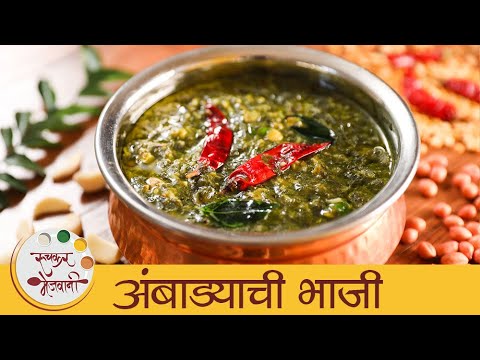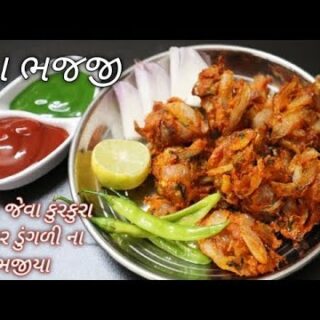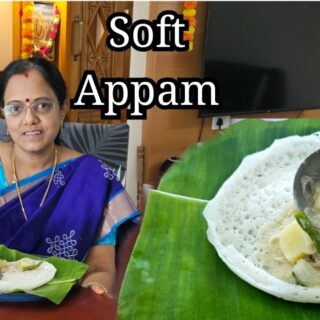Ambadichi Bhaji – अंबाडीची भाजी | Ambada Bhaji Recipe | How To Make Ambadichi Bhaji | Mugdha
Description :
पौष्टिक आणि झटपट अंबाड्याची भाजी | Ambadichi Bhaji Recipe | Healthy Ambada Bhaji Recipe | Ambada Bhaji In Marathi | अंबाड्याची भाजी | Gongura Leaves Recipe | How To Make Gongura Leaves Recipe | Poli Bhaji | Quick & Easy | Marathi Recipe | Ruchkar Mejwani | Mugdha Borse
Learn how to make Ambadichi Bhaji – अंबाड्याची भाजी with our chef Mugdha Borse
आज मुग्धा ताई घेऊन आल्या आहेत ” Ambadichi Bhaji – अंबाड्याची भाजी ” Recipe!
Ambadichi Bhaji – अंबाड्याची भाजी Ingredients:
– 1 & 1/2 cup Water
– 2 Bunch Gongura Leaves / Ambada (chopped)
– 1 & 1/2 cup Water
– 2 tbsp Yellow Split Peas (soaked)
– 2 tbsp Rice (soaked)
– 2 tbsp Peanuts (soaked)
– Water (as required)
– 1 tbsp Multi-grain Flour (roasted)
– Jaggery (as per taste)
– Salt (as per taste)
How To Make Tempering – Tadka Recipe – 3:53
– 2-3 tbsp Oil
– 1 tsp Mustard Seeds
– 1 tsp Cumin Seeds
– 8-10 Garlic Cloves (crushed)
– 3 Green Chillies (chopped)
– 10-12 Curry Leaves
– 1/4 tsp Turmeric Powder
– 1/4 tsp Asafoetida
– 2 Red Chillies
#RuchkarMejwani #AmbadyachiBhaji #अंबाड्याचीभाजी
Host: Mugdha Borse
Copyrights: REPL
Subscribe & Stay Tuned: http://bit.ly/SubscribeToRuchkarMejwani
For Facebook Updates: https://www.facebook.com/RuchkarMejwani
Twitter: https://www.twitter.com/RuchkarMejwani
Gongura is a plant, Roselle (Hibiscus sabdariffa), grown for its edible leaves in India. These leaves are used in south central Indian cuisine to impart a tart flavour. Gongura comes in two varieties, green stemmed leaf and red stemmed. The red stemmed variety is more sour than the green stemmed variety. Gongura is a rich source of iron, vitamins, folic acid and anti-oxidants essential for human nutrition.
Gongura pacchadi is quintessentially Andhra cuisine along with pacchadi (chutney or relish). Andhra people, mainly from Andhra Pradesh, locally called it as Andhra Matha (mother Andhra) in Telugu due to significance in their day to day diet. While it has many culinary uses, the most popular is the pickled version. Although Gongura is widely consumed all over Andhra Pradesh, Gongura is more popular in hotels, restaurants, eateries and food joints. It is also grown in Odisha, Tripura, Arunachal Pradesh (north east region of India) and also some parts of Chittagong Hill Tracts region in Bangladesh (which is mainly a tribal people region). It is a very popular green vegetable in Chakma community and it is known as “Aamelli”. Similarly, Gongura is popular in Tamil Nadu as well, and is called pulichakeerai (புளிச்சைக் கீரை) in Tamil. In Odisha it’s known as ଗୋରକୁରା (gorkura) or ଖଟା ପାଳଙ୍ଗ (khata palangaw). In Kerala it is called മത്തിപ്പുളി (Mathippuli), മീൻപുളി (Meenpuli) or പുളിവെണ്ട (Pulivenda). It is popular in North and Central Karnataka cuisines as “Pundi Palle/Punde soppu (ಪುಂಡಿ ಪಲ್ಲೆ/ಪುಂಡೆ ಸೊಪ್ಪು)”, and is regularly eaten with Jollad (Jowar) rotti. The famous combination with pulichakeerai is Ragi Kali/Ragi Mudde, which once used to be a regular food for the people in villages (since these items are easily available in agricultural forms). In Marathi, it is called Ambaadi (अंबाडी). And is specially prepared to a stew and served to goddess Mahalakshmi/Gauri during the annual festival of Mahalakshmi which falls on three days in between the ten days Ganesha Chaturthi festival in Maharashtra. It is known as Pitwaa in Hindi, Kotrum in Jharkhand, Mestapat in Bengali, Amaari in Chhattisgarhi, Pandi/Pundi in Kannada, Anthur in Mizo, Sougri in Manipuri, Sankokda in Punjabi, Aamelli in Chakma, Mwitha in Bodo, Kenaf Leaves in English, and Chin Baung in Chinese. It is a summer crop, and the hotter the place, the more sour the leaf gets.
| Date Published | 2021-03-03 11:08:31 |
| Likes | 408 |
| Views | 13693 |
| Duration | 5:48 |













